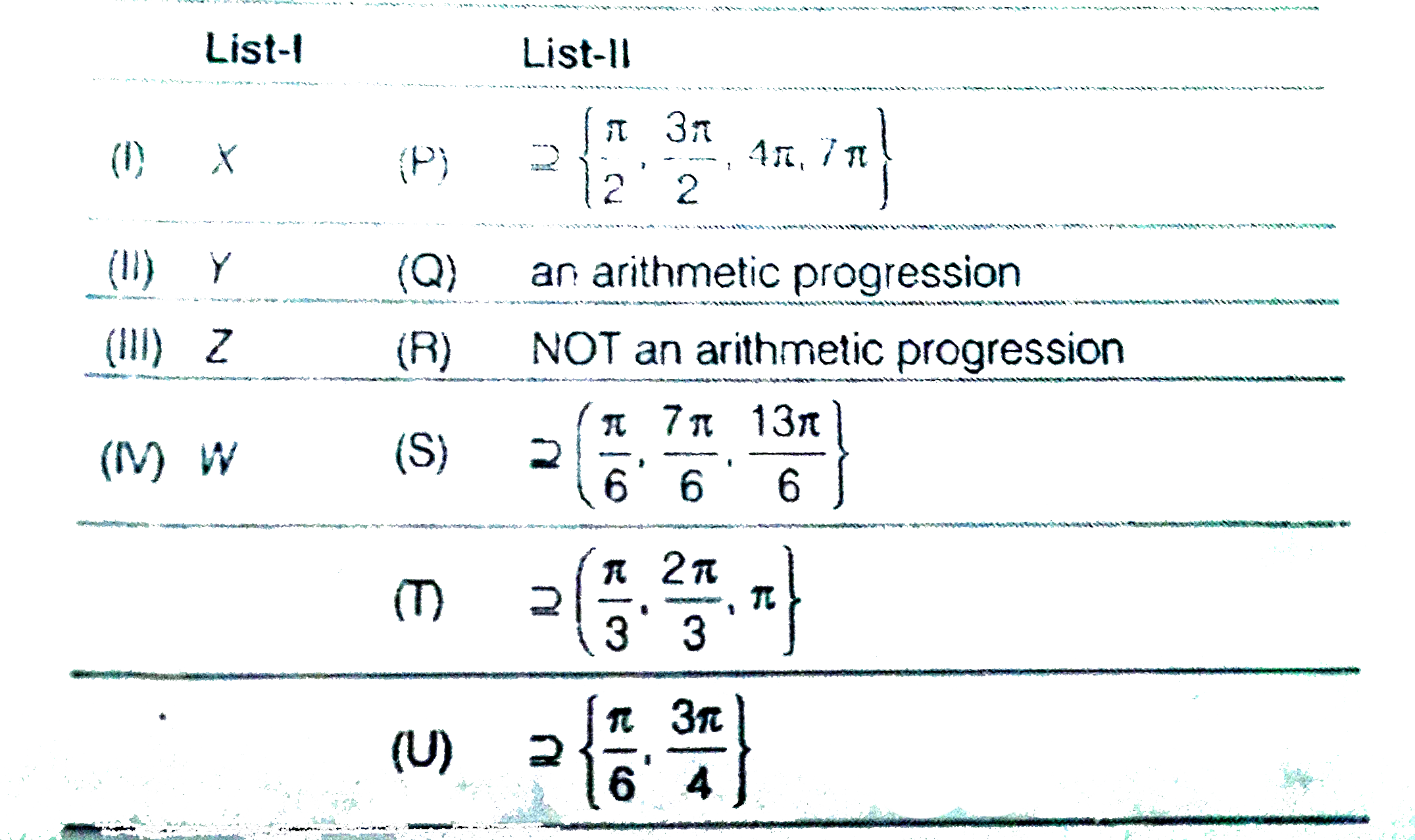Let f(x)=sin(πcosx)andg(x)=cos(2πsinx) be two finctions defined for x>0 . Define the following sets whose elements are written in the increasing order :
X={x:f(x)=0},Y={f'(x)=0}
Z={x:g(x)=0},W={g'(x)=0}
List -I contains the sets X,Y,Z and W. List -II contains some information regarding these sets.

Which of the following is the only CORRET combination ?
(IV),(P),(R),(S)
(III),(P),(Q),(U)
(III),(R),(U)
(IV),(Q),(T)
The correct Answer is:A
For Z={x:g(x)=0},x>0
∵g(x)=cos(2πsinx)=0
⇒2πsinx=(2n+1)π2∈integer
⇒sinx=2n+14
⇒sinx=−34,−14,14,14 [∵sinx∈[−1,1]]
here values of sinx,−34,−14,14,34 are in an A.P. but corresponding values of x are not in an AP so, (iii)→R.
For W={x:g'(x)=0},x>0
so, g'(x)=−2πcosxsin(2πsinx)=0
⇒eitherx=0 or sin(2pisinx)=0<br>rArreitherx=(2n+1)(pi)/(2)or 2 pi sin x =npi,n∈∫e>ers.<br>because 2pisinx=npi<br>rArr sin x =(n)/(2)=-1,-(1)/(2),0,(1)/(2),1 " "{because sin x in [-1,1)}<br>therefore x =npi,(2n+1)(pi)/(2)or npi+(-1)^n(+-(pi)/(6))<br>rArr (iv) to P,R,S
Hence , option (a) is correct.
Topper's Solved these Questions
- SOLVED PAPER 2019BOOK - IIT JEE PREVIOUS YEARCHAPTER - SOLVED PAPER 2019EXERCISE - Paper -2 section-2
6 Videos
- SEQUENCES AND SERIESBOOK - IIT JEE PREVIOUS YEARCHAPTER - SEQUENCES AND SERIESEXERCISE - RELATION BETWEEN AM,GM, HM AND SOME SPECIAL SERIES
34 Videos
- STRAIGHT LINE AND PAIR OF STRAIGHT LINESBOOK - IIT JEE PREVIOUS YEARCHAPTER - STRAIGHT LINE AND PAIR OF STRAIGHT LINESEXERCISE - GENERAL EQUATION OF PAIR OF STRAIGHT LINES (Objective Questions I) (Only one correct option)
1 Videos
Similar Questions
Let f(x)= sin(πcosx) and g(x)=cos(1πsinx) e two function defined for x>0 define the following sets whose elements are written in increasing order.
X={x:f(x)=0},Y={x:f'(x)=0}
Z={x:g(x)=0},W={x:g'(x)=0}
List IList II(I) X(P) ⊇{π2,3π2,4π,7π}(II) Y(Q) an arithmetic progression(III) Z(R) not an arithmetic progression(IV) W(S) ⊇{π6,7π6,13π6}(T) ⊇{π3,2π3,π}(U) ⊇{π6,3π4}
Q.
View SolutionLet f'(sinx)<0 and f''(sinx)>0∀x∈(0,π2) andg(x)=f(sinx)+f(cosx), then
View Solution
Knowledge Check
Answer the following by appropriately matching the lists based on the information given in the paragraph.
Let f(x)=sin(πcosx) and g(x)=cos(2πsinx) be two functions defined for x>0. Define the following sets whose elements are written in the increasing order:
X={x:f(x)=0},Y={x:f′(x)=0},Z={x:g(x)=0},W={x:g′(x)=0}
List-I contains the sets X,Y,Z and W. List-II contains such some information regarding these sets:
Which of the following is the only CORRECT combinations?A(II),(R ), (S)B(I), (P), (R )C(II), (Q), (T)D(I), (Q), (U)Answer the following by appropriately matching the lists based on the information given in the paragraph.
Let f(x)=sin(πcosx) and g(x)=cos(2πsinx) be two functins defined for x>0. Define the following sets whose elements are written in the increasing order:
X={x:f(x)=0},Y={x:f′(x)=0},Z={x:g(x)=0},W={x:g′(x)=0}
List-I contains the sets X,Y,Z and W. List-II contains such some information regarding these sets:
Which of the following is the only CORRECT combinations?A(IV),(Q),(T)B(IV),(P),(R ),(S)C(III),( R),(U)D(III),(P), (Q),(U)Let f(x)= sin(πcosx) and g(x)=cos(1πsinx) e two function defined for x>0 define the following sets whose elements are written in increasing order.
X={x:f(x)=0},Y={x:f'(x)=0}
Z={x:g(x)=0},W={x:g'(x)=0}
List IList II(I) X(P) ⊇{π2,3π2,4π,7π}(II) Y(Q) an arithmetic progression(III) Z(R) not an arithmetic progression(IV) W(S) ⊇{π6,7π6,13π6}(T) ⊇{π3,2π3,π}(U) ⊇{π6,3π4}
Q. Which of th following is the only correct combinationAIV-(P),(R),(S)BIII-(R),(U)CIII-(P),(Q),(U)DIV-(Q),(T)
Let f(x)=x+logex−xlogex,x∈(0,∞)
List I contains information about zero of f(X) ,f'(x) and f''(x)
List II contains information about the limiting behaviour of f(x), f(x) and f''(x) at infinty
List III contains information about increasing /decreasing nature of f(x) and f'(x)

which o fhte following options is the only CORRECT comibination?
View SolutionLet f(x)=√x and g(x)=x be two functions defined over the set of nonnegative real numbers. Find (f+g)(x), (f−g)(x), (fg)(x) and (fg)(x).
View SolutionLet f(x)=√xand g(x)=xbe two functions defined over the set of nonnegative real numbers. Find (f+g)(x), (fg)(x), (fg)(x)and (fg)(x).
View Solutionlet f(x) =√x and g(x) =x be function defined over the set of non negative real numbers . find (f+g)(x),(fg)(x)and(fg)(x) .
View SolutionLet y=f(x) and y=g(x) be two monotonic, bijective functions such that f(g(x) is defined than y=f(g(x)) is
View Solution


